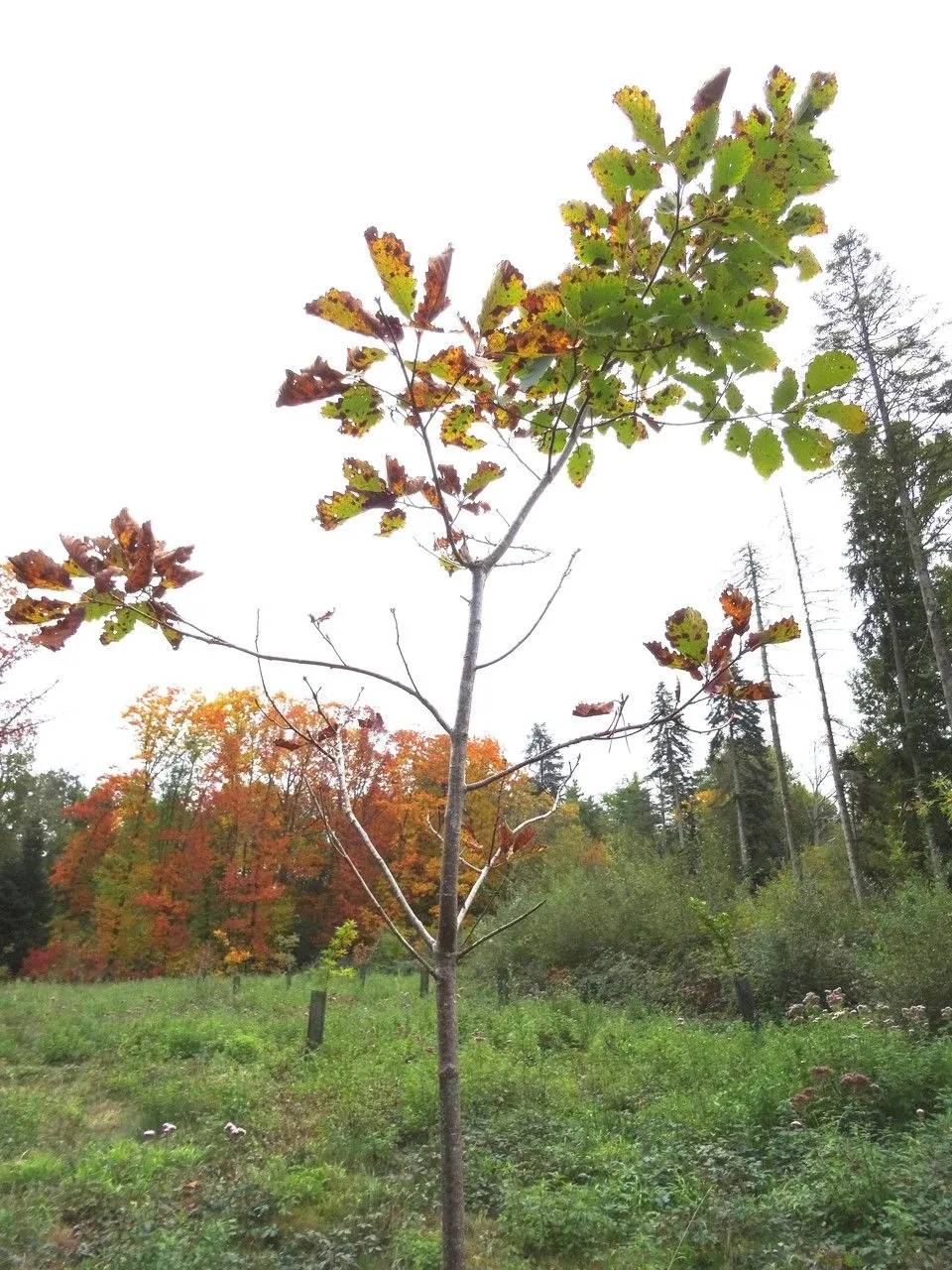
Author: Willd.
Bibliography: Neue Schriften Ges. Naturf. Freunde Berlin 3: 396 (1801)
Year: 1801
Status: accepted
Rank: species
Genus: Quercus
Vegetable: False
Observations: SE. Canada to NC. & E. U.S.A.
The swamp white oak, scientifically known as Quercus bicolor, is a remarkable species of oak native to a diverse array of landscapes in southeastern Canada, the northeastern United States, and down to North Carolina. This deciduous tree belongs to the Fagaceae family and is distinguished by its unique adaptations and striking features.
Swamp white oak is a large, robust tree that can attain heights of up to 60 to 80 feet, with a broad, rounded crown that provides ample shade. Its bark is deeply furrowed and ridged, creating an intricate pattern that adds to its visual appeal. The leaves of Quercus bicolor are notable for their bi-colored appearance: the upper surface is a shiny, dark green, while the underside is a contrasting silvery white, a feature that can make the tree appear to shimmer in the breeze.
In terms of habitat, the swamp white oak favors wet, swampy areas as its name suggests, thriving in poorly drained, acidic soils where other oak species might struggle. It is often found along streams and rivers, floodplains, and swamp forests. This ecological preference reflects the tree’s adaptability to saturated environments, making it an important player in the maintenance of such ecosystems.
Ecologically, Quercus bicolor plays a vital role in its native habitats. It provides food and shelter for a variety of wildlife. The acorns produced by the swamp white oak are a significant food source for mammals and birds, while the tree itself offers nesting sites and cover for numerous species.
The swamp white oak was first described in 1801 in the journal “Neue Schriften Ges. Naturf. Freunde Berlin”, reflecting the historic academic interest in cataloging and understanding this tree. Named and classified by the botanist Willd., the swamp white oak remains a subject of interest for its ecological significance and resilience.
In cultivation, swamp white oak is valued for its growth form, longevity, and adaptability to urban and rural environments. It is often planted in parks and large gardens where it can be appreciated for its aesthetic qualities and environmental benefits, such as shading, air purification, and enhancing local biodiversity.
Understanding and preserving the swamp white oak is crucial, not only for maintaining the health of wetland ecosystems but also for appreciating the rich biodiversity and complex interactions within these habitats. As we continue to study and conserve Quercus bicolor, it stands as a testament to the intricate beauty and functionality of native North American flora.
Eng: swamp white oak
Fra: chêne bicolore, chêne bleu
En: Swamp white oak
Ar: سنديان ذو لونين
Bg: Двуцветен дъб
Zh: 黄背栎
Cs: Dub dvoubarevný
Nl: Tweekleurige eik
Fi: Jokivalkotammi, Valkojokitammi
Fr: Chêne bicolore, Chêne bleu
De: Zweifarbige Eiche
Lv: Divkrāsu ozols
Fa: بلوط دورنگ
Pl: Dąb dwubarwny
Ru: Дуб двуцветный
Zh-tw: 沼澤白橡
Tr: Bataklık ak meşesi
Taken May 30, 2020 by J D (cc-by-sa)
Taken Oct 22, 2015 by Tela Botanica − Alain BIGOU (cc-by-sa)
Taken Oct 22, 2015 by Tela Botanica − Alain BIGOU (cc-by-sa)
Taken Oct 22, 2015 by Tela Botanica − Alain BIGOU (cc-by-sa)
Taken Oct 22, 2015 by Tela Botanica − Alain BIGOU (cc-by-sa)
Taken Jul 14, 2021 by GEORGE GASPAR (cc-by-sa)
Taken Oct 26, 2022 by simard qu marc (cc-by-sa)
Taken Nov 26, 2021 by Greta Van Loon (cc-by-sa)
Taken Oct 17, 2022 by Michael Cahill (cc-by-sa)
Taken Oct 22, 2015 by Tela Botanica − Alain BIGOU (cc-by-sa)
© copyright of the Board of Trustees of the Royal Botanic Gardens, Kew.
© copyright of the Board of Trustees of the Royal Botanic Gardens, Kew.
Taken Sep 22, 2020 by Shuji Usui (cc-by-sa)
Taken Aug 8, 2019 by Ram Chandra Ram Chandra Nepal (cc-by-sa)
Taken Aug 10, 2021 by William Coville (cc-by-sa)
Taken Oct 22, 2015 by Tela Botanica − Alain BIGOU (cc-by-sa)
Taken Oct 22, 2015 by Tela Botanica − Alain BIGOU (cc-by-sa)
Taken Aug 29, 2021 by Rossi Sveva (cc-by-sa)
Taken Sep 16, 2022 by u u (cc-by-sa)
Taken Aug 29, 2022 by barb mck (cc-by-sa)
Taken Sep 20, 2022 by Lisa H (cc-by-sa)
Taken Jul 23, 2021 by Lang Cheng (cc-by-sa)
Taken May 17, 2022 by Matthias Foellmer (cc-by-sa)
Taken Aug 29, 2021 by Rossi Sveva (cc-by-sa)
Growth form: Single Stem
Growth habit: Tree
Growth rate: Rapid
Ph maximum: 6.5
Ph minimum: 4.3
Light: 8
Atmospheric humidity: 5
Soil nutriments: 4
Family: Myrtaceae Author: (F.Muell.) K.D.Hill & L.A.S.Johnson Bibliography: Telopea 6: 402 (1995) Year: 1995 Status:…
Family: Rubiaceae Author: Pierre ex A.Froehner Bibliography: Notizbl. Bot. Gart. Berlin-Dahlem 1: 237 (1897) Year:…
Family: Sapindaceae Author: Koidz. Bibliography: J. Coll. Sci. Imp. Univ. Tokyo 32(1): 38 (1911) Year:…
Family: Asteraceae Author: A.Gray Bibliography: Pacif. Railr. Rep.: 107 (1857) Year: 1857 Status: accepted Rank:…
Family: Fabaceae Author: Medik. Bibliography: Vorles. Churpfälz. Phys.-Ökon. Ges. 2: 398 (1787) Year: 1787 Status:…
Family: Aspleniaceae Author: (Cav.) Alston Bibliography: Bull. Misc. Inform. Kew 1932: 309 (1932) Year: 1932…